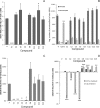A focused small-molecule screen identifies 14 compounds with distinct effects on Toxoplasma gondii
- PMID: 22908155
- PMCID: PMC3486605
- DOI: 10.1128/AAC.00868-12
A focused small-molecule screen identifies 14 compounds with distinct effects on Toxoplasma gondii
Abstract
Toxoplasma gondii is a globally ubiquitous pathogen that can cause severe disease in immunocompromised humans and the developing fetus. Given the proven role of Toxoplasma-secreted kinases in the interaction of Toxoplasma with its host cell, identification of novel kinase inhibitors could precipitate the development of new anti-Toxoplasma drugs and define new pathways important for parasite survival. We selected a small (n = 527) but diverse set of putative kinase inhibitors and screened them for effects on the growth of Toxoplasma in vitro. We identified and validated 14 noncytotoxic compounds, all of which had 50% effective concentrations in the nanomolar to micromolar range. We further characterized eight of these compounds, four inhibitors and four enhancers, by determining their effects on parasite motility, invasion, and the likely cellular target (parasite or host cell). Only two compounds had an effect on parasite motility and invasion. All the inhibitors appeared to target the parasite, and interestingly, two of the enhancers appeared to rather target the host cell, suggesting modulation of host cell pathways beneficial for parasite growth. For the four inhibitors, we also tested their efficacy in a mouse model, where one compound proved potent. Overall, these 14 compounds represent a new and diverse set of small molecules that are likely targeting distinct parasite and host cell pathways. Future work will aim to characterize their molecular targets in both the host and parasite.
Figures








References
Publication types
MeSH terms
Substances
Grants and funding
LinkOut - more resources
Full Text Sources
Other Literature Sources

